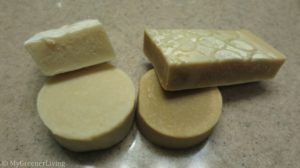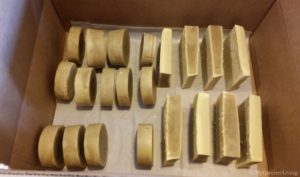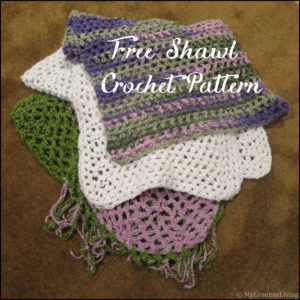
One way I am able to keep on budget while still being able to give nice gifts is to make gifts. Over the years I have received much positive feedback on my homemade gifts of soap, relish, cookies, and crocheted items. Homemade items are great because many people really appreciate receiving homemade gifts, and you can usually make them for less money than purchasing a similar item. Just make sure you’re gifting these homemade items to people who you expect to like that kind of item. For example, I gave my guy friends who love food (who doesn’t, really?) my sweet pepper relish and it was appreciated, but if I gave them this shawl, I doubt they would be thrilled.
Disclaimer: This post contains affiliate links, which means I may receive compensation if you make a purchase through these links. There is no cost to you. See my Disclosure Policy for more information.
I first saw this shawl many years ago when my cousin gave me this beautiful hand-crocheted shawl (it’s the one in the bottom of the picture above!). A couple years ago my coworker taught me to crochet, and I decided I wanted to make one of these shawls for myself. Luckily my cousin remembered where she found the pattern, called Julie’s Tears, and sent it to me.

When I started trying to make this shawl, I could not keep the stitches per row consistent and I did not like how the shawl was coming out (8 rows in I could tell I was going to end up with a triangle). So I started over and adjusted the pattern to make it work for me. The shawl ends up looking the same, but I find it much easier for me to make. If you want to make this shawl, you now have 2 options – follow the pattern that works best for you.
Supplies
- 430 yards bulky (5) yarn. I use Loops & Threads Charisma, and use 4 skeins.
- Q (50mm) crochet hook
- tapestry needle
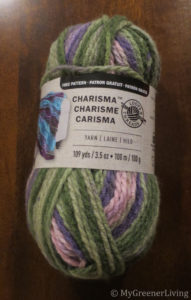
Stitches used
- slip knot
- chain (ch)
- half double crochet (hdc)
My finished product is about 22″ wide by 54″ long. It’s very stretchy, and will have a tendency to stretch along the length, so it will likely end up a little narrower after you throw it over your shoulders.
If you follow this pattern starting with ch 53, each row will have 26 hdcs (actually it’s 25 hdcs and one portion of the ch 3; this pattern counts the ch 3 at the beginning of each row as a hdc stitch).
Free shawl crochet pattern
Row 1: Tie a slip knot onto the crochet hook, and chain 53. (For wider or narrower, chain a multiple of two, and add three.)
Row 2: Hdc in third st from hook. *Sl st. Skip one chain and hdc into next.* Repeat * until end of row.
Row 3: Turn. Ch 3 (counts as one hdc). Hdc into the first ch space between hdcs in the previous row. *Ch 1, hdc into next ch space.* Repeat * to end of row. Ch 1, hdc into the gap formed by the 3 chs from the previous row. Hdc into the second ch of the 3 chs from previous row. [Note that there is NOT a ch between the last two hdcs in the row.]
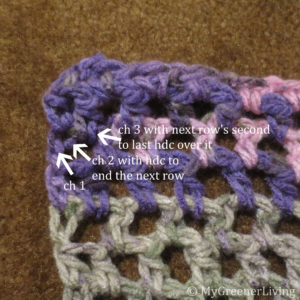
Row 4-end: Turn. Ch 3. Hdc into the first ch space between hdcs in the previous row [you’re skipping over two hdcs in the previous row to get to this first chain space]. *Ch 1, hdc into next ch space.* Repeat * to end of row. Ch 1, hdc into the gap formed by the 3 chs from the previous row. Hdc into the second ch of the 3 chs from previous row. [Again there is no ch between the last two hdcs in the row.]
Repeat Row 4 until desired length is reached. Fasten off and weave in tails. I repeated until my 4 skeins of yarn were used up to achieve the (about) 54 inch length.
I’d say I am an intermediate crocheter, and this shawl takes me about 8 hours to make. It’s great to work on while watching TV, since most stitches are through big chain spaces. More so than other crochet projects, I don’t need to pay much attention to what I am doing when crocheting this.
Cost
Loops and Threads Charisma is sold at Michael’s.
Regular price of the Loops and Threads Charisma is $4.49 + sales tax. Using 4 skeins, the cost is ($4.49×1.07)x4=$19.22.
The best sale I have seen on this yarn was $2/skein, or ($2×1.07)x4=$8.56
There are often coupons for 40% off, occasionally 50% off one regular priced item on the Michael’s website or app each week, and on the weekends additionally a coupon for 20% or 30% off your entire regular price purchase. Keep an eye out for coupons and weekly sales to save on this yarn!
Do you gift homemade items? What kind?



